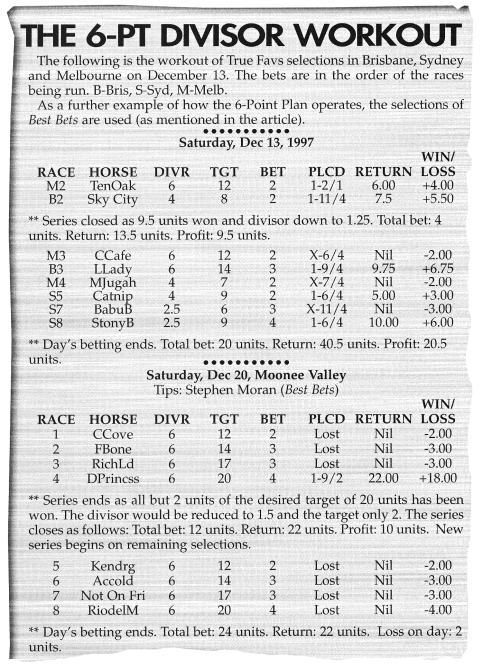
A friend said to me recently, 'What's all the fuss over this 6-Point staking plan? Is it any good?' I told him the fuss was over the fact that it could inject some excitement into one's betting, and that on a set of good selections it could give you a significant edge over level-stakes betting.
Now I think most will agree that level-stakes betting, putting the same amount on each selection, is as boring as watching paint dry It may be, as is claimed, safe and sound ... but there's always that nagging feeling we could all do better if we only took a bit more risk.
The 6-Point Plan doesn't add risk but it does give you a decent chance of turning a small levelstakes profit into a much larger profit. So have I got your attention? Guess I have!
Years ago, one of our leading professionals said of the plan: 'It is the soundest of all target staking methods and on all selections has stood the test of time since the early 1930s.'
This man had been betting for some 25 years when he made that statement. He had operated the 6Point Plan for much of that time and says he was never in any financial trouble. His selections were sound and if he got into a losing run he simply introduced the plan's Safety Brake.
There is no need to be frightened of implementing the 6-Point Plan. You are not going to be caught up in chasing enormous losses. This is a safety-first plan and it operates beautifully on sound selections.
The aim is to win six betting points every time you back a winner, or winners, whose odds total six. The target decides the opening bet. For example: If you were aiming to win $6, the first bet would be $1; that is, 6 divided into 6. If your target (or objective) was to win $12, then the opening bet would be $2 (6 divided into 12).
The procedure is just a matter of simple division into the amount you want to win. It's not necessary to know the return from a winner until after the winner has been struck, and you then do the necessary subtractions.
Let's say you have a day's betting and you pick only one winner, like a certain tipster did at Moonee Valley on December 20. We will follow his tips for that day, using the 6-Point Plan, with a target of $12 and a divisor of 6.
His first selection loses. The $2 bet is lost. This is now added to the target, making it now $14. You divide 6 into 14. That makes 2.5 but we will round this off to 3. So the next bet is $3. It loses. The loss is added to the target, taking it now to $17. The divisor remains at 6, so the next bet is $3 again.
The third bet loses as well. Another $3 loss. This is added to the target, taking it to $20. The divisor remains at 6. The next bet, then, is 3.5 but we round this up to $4.
The next bet, Drinkcard Princess, wins at 9/2. Your return is $22. The situation now is that with that one winner you have bet a total of $12 for a return of $22, a profit of $10. So you have achieved just about all your target of $12. Your divisor has been reduced by the total price of the winner (9/2) so you are now in the position of having a
divisor of 1.5 and a target of only $2.
In situations like this, you simply close off the series and start a new one from the next race. As it turned out, this tipster then hit another four losers. This meant a loss of $12. In all, then, the day ended up with bets totalling $24 for a return of $22, a loss of $2.
But what would have happened if you had been betting at level stakes? Let's say you had 8 bets at $3 each ($24). Your return on the sole winner at 9/2 would be $18, leaving you with a loss of $6 on the day, compared with only $2 using the 6-Point Plan.
So the 6-Point Plan loses 8.3 per cent on turnover, while level stakes loses 25 per cent! Quite a difference. And remember that both staking approaches have bet the same amount of money.
My personal tactic with the 6Point Plan is that I introduce the Safety Brake once I have struck a losing run of six. What is the Safety Brake? Simply an extra divisor figure and an increased target figure.

The Brake is applied any time you consider the bets are rising too steeply due to a run of losers. The divisor may be 6 when you strike a slump which takes the target out to, say, $60, calling for a bet of $10. By adding a new divisor (6) and a new target (12), the new figures would be a divisor of 12 into a target of $72, calling for a bet of $6 and not $10.
It doesn't matter how many times you introduce a Safety Brake. It's there to be employed for sensible money management. Never hesitate to use it. It reduces liability and will not alter the eventual outcome. As soon as you win the desired target you are ahead by the amount you predetermined.
Last issue, I unveiled the True Favs plan, whereby you back favourites which firm or hold their line in the betting from no higher an opening quote of 3/1. On this page you will find a workout of the three city meetings run on December 13. Once again, the 6 Point Plan shows a better return than using level stakes. On this day, a total of $20 was bet on eight selections for five winners.
This was a fine day's betting. Both the 6-Point Plan and level stakes were tested race by race. The 6-Point Plan showed a profit of 20.5 units, just over 100 per cent, but level stakes, betting the same amount of money across the eight selections, returned a profit of only 17.5 units.
The 6-Point Plan produced a profit of 102.5 per cent while level stakes managed only 87.5 per cent. This is a large difference of 15 per cent.
Imagine if you were betting in large amounts? Let's say you bet $2000 and got back $4050 using the 6-Point Plan. With level stakes you would bet $2000 and get back only $3750. That's a difference of $300!
Now you can see what I mean by the 'edge' that can be gained from the 6-Point Plan. Have a look at the workouts and you will get the drift of how the plan works. It's very easy to operate.
If nothing else, the plan will inject some fun and excitement into your betting. You'll see your bets rise and fall with the tide but you will always know that once you have secured your target - well, you're in profit. The job is done!
Click here to read Part 1.
By Martin Dowling
PRACTICAL PUNTING - FEBRUARY 1998